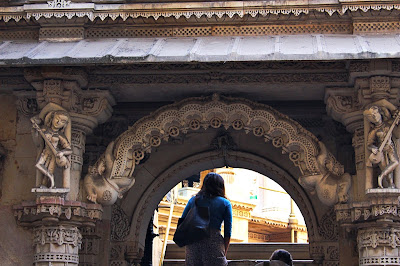A brief History
The First World Heritage City of India, Ahmedabad was founded in the year 1411.
Solanki rulers founded a city named Karnavati in the eleventh century on the banks of Sabarmati river after establishing their victory over the Bhils. Many subsequent battles gave Karnavati many different rulers in different times. At the end of the thirteenth century an independent Sultanate ruled by the Muslim Mazaffarid dynasty was established. The fourteenth Sultan Ahmed Shah renamed Karnavati as Ahmedabad and established it as his capital. Ahmedabad was the capital of the Sultanate for 162 years (1411 - 1573). The city has presence of all the architectural wonders created during those years.
A walk to remember
 |
| Swaminarayan Mandir, Kalupur |
The uniqueness of this walk is that it starts from a temple and ends at a mosque. "Mandir se Masjid Tak" as it is popularly referred to as. The walk commences at the Swaminarayan Mandir in the heart of the old city of Ahmedabad in Kalupur at 07:30 am. Dedicated to the Twin Hindu Gods Nara and Narayana, this temple is an architectural marvel to behold. The beautiful carvings and the use of bright colours to decorate the temple stand out. The temple complex has a multi storeyed air-conditioned guest house and a medical centre. The darshans open at 08:30 am onwards.
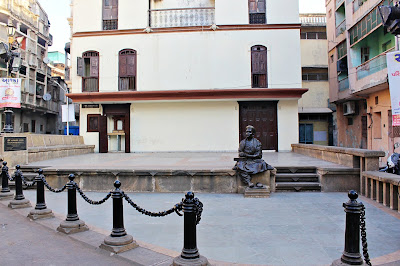 |
| Kavi Dalpatram Chowk |
 |
| Blessings received from Dadaji! |
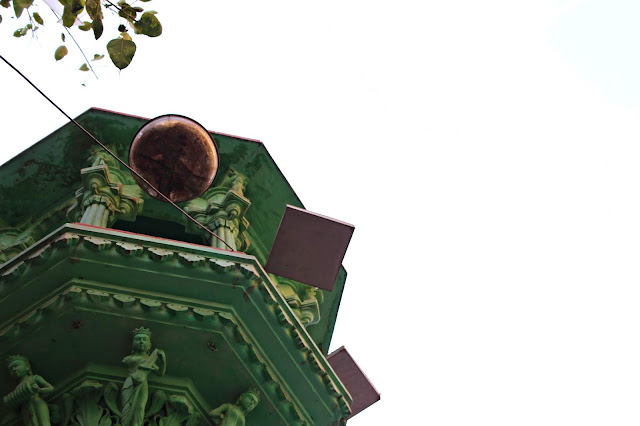 |
| Kabootarkhana |
From the temple the guided walk moves towards the inside of the old city transporting one to the era gone by where everyone knew everyone, homes welcomed with open arms and doors and roads were treaded barefoot. Next stop is the Kavi Dalpatram Chowk, Lambeshwar Ni Pol. Kavi Dalpatram was a scholar and poet who strongly advocated the cause of women's empowerment. A highly revered gentleman he was lovingly referred to as Dada by one and all. His house has been modelled into a museum cum amphitheatre and is a memorial to this great poet and reformer. The museum is termed a "live-museum". The memorial, a platform with the map of the original house etched on it and a wall depicting the facade of the house as the backdrop, is actually a stage where Kavi Dalpatram's plays are staged on his birth anniversary. The locals from the area sit around and children play here every evening. There is a bronze statue of Kavi Dalpatram gracing the entrance to the memorial and to sit in the statue's lap is considered a blessing.
 |
| A traditional Pol in the old city |
Traversing the narrow lanes of the old city towards the Calico Dome, the next stop, one can not help but notice the ornate towers that dot the town. These are bird feeding towers or Kabootarkhanas. The compassionate people of Gujarat from across all faiths build these towers next to their places of worship. The base of the tower is a storage for grains and bird feed, and at the top near the dome hang trays filled with feed and water for the birds. Some towers even have pigeon holes built in them for the birds to get shelter and rest.
Next on the walk comes the relief road, which also now needs a relief road looking at the heavy traffic flow! Across the relief road is the place where the historical Calico Dome once saw the hustle and bustle of the Fashion Industry. Many a models and fashion designers started their successful careers here. Unfortunately, the dome was lost to the massive earthquake of 2001. The Ahmedabad Municipal Corporation later took over the place and restored the remains keeping the heritage of Calico Dome alive.
Just as the kabootarkhanas are an important feature of Gujarat, so are the Pols. Pols are gated societies where people belonging to one particular community lived together. The segregation was done to have a harmonious co-habitation with people from same background and food habits living together. However all these Pols were interconnected through secret passages to provide a safe escape route to the residents in case of any invasion / attack.
 |
| Kala Ram Ji |
The Pol that is included in the walk is the Khara Kuva Ni Pol or the Pol of the saline water well. This Pol houses a unique and famous Kala Ram Ji Temple (Temple of Black Ram Ji). Some interesting uniquenesses of this temple :
1. It is a home temple with no dome or flag but three stories of a house with 80 rooms where many families reside.
2. Lord Rama is shown in a black avatar.
3. Lord Rama is in a sitting meditative posture.
4. One of the handful of temples where Lord Rama is seen without his confidante Lord Hanuman. Mythology says that Lord Rama met Hanuman in Kishkindha after Devi Sita's abduction by Ravana, but in this temple Lord Rama is seen in meditation in Panchvati much before the abduction of Devi Sita.
As one wonders and is busy processing all of this invaluable information, the walk crosses over to another street which has a very tall metal pipe sticking out of the ground with a wind vane on top. This isn't a wind vane though, it is an exhaust for the toxic fumes and gases from the sewage tank below the ground. See, how well the sanitation was planned in the World Heritage City of Karnavati or Ahmedabad as we now know it.
Pol hopping brings the walk to another Pol, Shantinathji Pol, where the highlight is another bird feeding tower and three Derasars or Jain Temples within a distance of a few hundred meters from each other.
A striking feature of the homes of old city of Ahmedabad is the construction of walls where wooden blocks are interspersed with concrete bricks. This unique architectural intelligence served as a natural shock absorber that resulted in zero damages to the heritage homes during the devastating earthquake of 2001.
 |
| Earthquake proof construction |
The next turn brings this heritage walk through one of those secret passages we mentioned earlier, to the Kuvawala Khancha. This quiet corner is an art gallery in itself with four different architectural styles showcased in one little street corner! There are homes made in Mughal, Maratha, British and Persian styles.
Yet another noticable feature in the walls of the heritage buildings are Popat Ni Gokh. These are tiny insulated apertures left in the outer walls of buildings at heights of more than ten feet from the ground for Parrots to build their nests in them and thus aptly named Popat Ni Gokh the translation of which is Homes of Parrots.
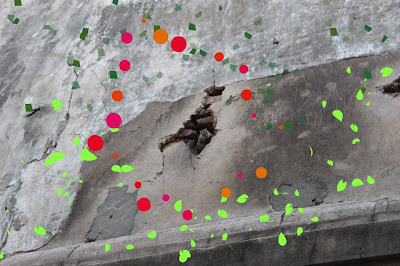 |
| Popat Ni Gokh, encroached upon by a squirrel :) |
This marks the half way mark in the walk when the walk reaches the magnificently wood-carved Dodhia Haveli - a homestay in the old city of Ahmedabad. Many businessmen who now live abroad and have ancestral homes in Gujarat, have converted their homes / havelis into home stays. There are multi-talented attendants who keep the charm of these heritage homes intact and are skilled to dish out most lip smacking Gujarati delicacies.
 |
| Welcome! |
Next is a Derasar known as Astapadji Derasar, a very uniquely carved Jain Temple with a perfectly functioning rain water harvesting system. Photography is strictly prohibited in the temple complex.
The heritage walk is a great way to get a glimpse into the architecture of yore as well as the stories from the past. The guide regales the participants with many interesting anecdotes from the chapters of history. One, that is particularly mentionable is of a noble lady by the name of Shethani Harkuvar whose Haveli is an important landmark near Fernandez Bridge. The beautifully carved haveli was once among the largest and tallest buildings of Ahmedabad. Shethani Harkuvar was very progressive in her thinking and supported the cause of women's education. She in collaboration with Kavi Dalpatram built a school for the local girls.
Next is the Fernandez Bridge and Chandla Ol. The first flyover of the city, Fernandez Bridge was built during the British Era. The largest text-book market is set up under the bridge every day. Students in all age groups flock this market where one can get lucky to get one's hands on a as-good-as-new second-hand book too. The many shops around here have their owners living on the floors above the shops. Another smart feature - no travel time to and from work!

Next few shops are sweetmeat shops and these lanes then converge into the popular Manek Chowk. Manek Chowk is abuzz with life 24 hours a day - a well thought out plan to keep the business district of the city safe from any possibilities of theft or robberies. A vegetable market during early hours of the day, makes way for the bustling jewellery market which in the evening shuts down to let many street food hawkers set shop. The riot of a food bonanza keeps the place alive till wee hours in the morning. The popularity of this place is such that one has to wait for a while to get served. Manek Chowk is flanked by Rani No Hazeero on one side and Badshah Ka Hazeera on the other. A little information here : The final resting place of persons from royal lineage is called a Hazeera, that of a saint is called a Mazaar and the one for common people is referred to as a Kabristan. Men are allowed inside the main mausoleum at the Hazeera while women are not. This is the final resting place of Sultan Ahmed Shah, founder of Ahmedabad.
Just in front of the Hazeera are homes of locals with many graves interspersed with the living quarters, some inside rooms and many in the open spaces between houses. Clearly sending out a message that life forms a complete circle! What has arrived must someday leave too.
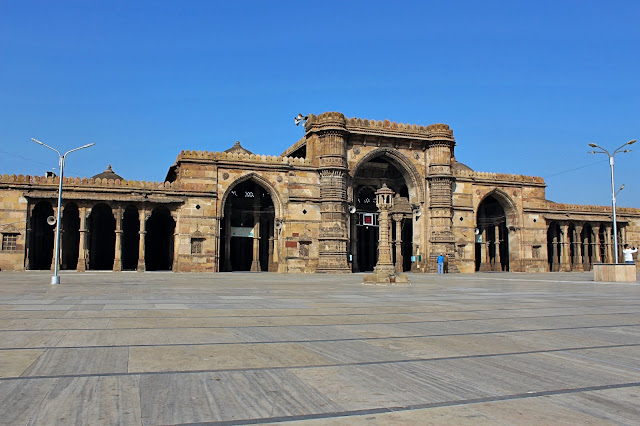 |
| Jama Masjid, Ahmedabad |
The final destination in this 2 kms long heritage walk is the Jama Masjid / Jami Masjid which gets its name from Jumma which means Friday in Arabic. The Jama Masjid of any city is the largest mosque of that city.
The heritage walk brings the participants to the second gate of the mosque, where they need to remove and carry their shoes to be kept outside the main gate of the mosque as the walk culminates outside the main gate of The Jama Masjid. A strict dress code is observed at the mosque -
Women : Cover your arms and legs
Men : Cover your legs
 |
| Houd-e-Vazu |
This mosque was built by Badshah Ahmed Shah and has some very unique and striking features ; The architecture is a mix of Jain, Hindu and Mughal Architectural styles. The main mosque does not have a dome. A separate elevated prayer room is made for women. A huge Houd - e - Vazu (the pond for cleansing) graces the centre of the expansive courtyard. At a time around 5000 pilgrims can pray here. The corridors around the courtyard have holy inscriptions painted on the walls. Marvel at this wondrous place of worship and leave with memories for a lifetime.
Now some authentic Gujarati snack
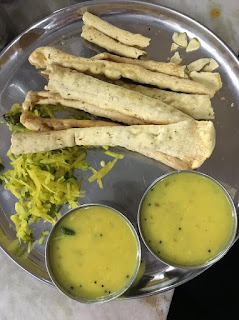 |
| Fafda with Kadhi and Raw Papaya Condiment |
 |
| The most scrumptious Jalebis |
All that walking is sure to make one hungry, the participants can head to the nearby Chandravilas - a century old restaurant which boasts of patrons like Mahatma Gandhi, Sardar Patel, Raj Kapoor and many famous personalities. A scrunchy bite into a juicy jalebi and a mouthful of flavourful Khaman will leave you wanting more. Then there is the local speciality Fafda with kadhi and raw papaya chutney.











